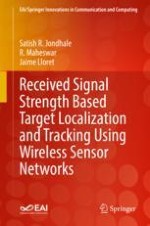2022 | OriginalPaper | Chapter
2. Target Localization and Tracking Using WSN
Authors : Satish R. Jondhale, R. Maheswar, Jaime Lloret
Published in: Received Signal Strength Based Target Localization and Tracking Using Wireless Sensor Networks
Publisher: Springer International Publishing
Activate our intelligent search to find suitable subject content or patents.
Select sections of text to find matching patents with Artificial Intelligence. powered by
Select sections of text to find additional relevant content using AI-assisted search. powered by
